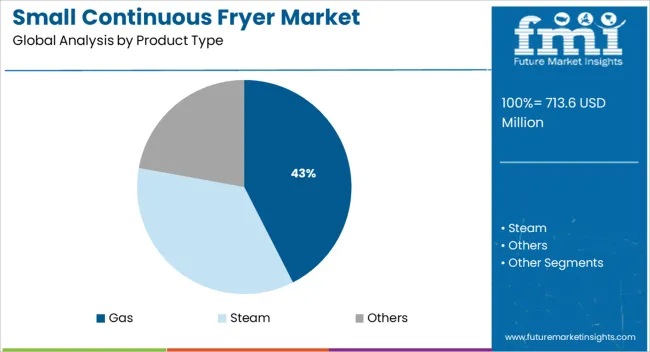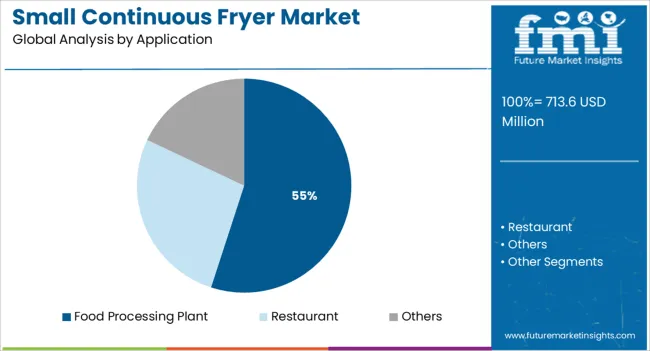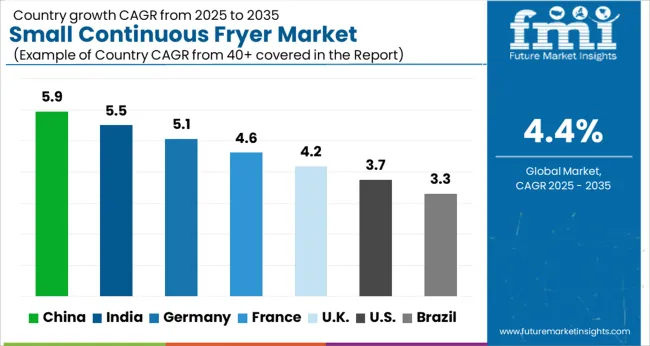The Small Continuous Fryer Market is estimated to be valued at USD 713.6 million in 2025 and is projected to reach USD 1097.6 million by 2035, registering a compound annual growth rate (CAGR) of 4.4% over the forecast period.

| Metric | Value |
|---|---|
| Small Continuous Fryer Market Estimated Value in (2025 E) | USD 713.6 million |
| Small Continuous Fryer Market Forecast Value in (2035 F) | USD 1097.6 million |
| Forecast CAGR (2025 to 2035) | 4.4% |
The small continuous fryer market is witnessing consistent growth as food manufacturers prioritize efficiency, consistency, and sustainability in their operations. Demand for compact and energy-efficient frying solutions has been rising as producers aim to balance high throughput with reduced operational costs and lower environmental impact.
The shift toward automation and hygienic design in food production facilities has also supported adoption, with fryers offering improved oil management, uniform heat distribution, and ease of cleaning being favored. Future growth is expected to benefit from increasing consumption of fried snacks and ready-to-eat meals, coupled with rising investments in modernizing food processing plants to meet evolving food safety and quality standards.
Advances in energy recovery systems, filtration technology, and flexible designs tailored to diverse product lines are paving the path for further adoption across both established and emerging markets.
The market is segmented by Product Type and Application and region. By Product Type, the market is divided into Gas, Steam, and Others. In terms of Application, the market is classified into Food Processing Plant, Restaurant, and Others. Regionally, the market is classified into North America, Latin America, Western Europe, Eastern Europe, Balkan & Baltic Countries, Russia & Belarus, Central Asia, East Asia, South Asia & Pacific, and the Middle East & Africa.

When segmented by product type, the gas segment is projected to account for 42.5 % of the total market revenue in 2025, establishing itself as the leading product category. This leadership has been driven by the preference for faster heating times, lower operational costs, and enhanced temperature control offered by gas-powered fryers.
Observations in the industry indicate that gas fryers have been widely adopted in facilities where access to reliable and affordable natural gas is prevalent, enabling significant energy savings compared to electric alternatives. Their ability to sustain higher production rates and maintain consistent frying quality over extended periods has reinforced their dominance in demanding production environments.
Further, design improvements aimed at improving heat transfer efficiency and reducing emissions have contributed to strengthening the position of the gas segment within the market.

When segmented by application, food processing plants are expected to hold 55.0% of the market revenue in 2025, securing their place as the largest application segment. This prominence has been attributed to the central role these facilities play in producing large volumes of fried products for both retail and foodservice channels.
Food processing plants have increasingly invested in small continuous fryers to enhance product quality, reduce oil wastage, and comply with stringent hygiene and safety standards. The ability of these fryers to operate continuously with minimal downtime and deliver consistent results across different product types has made them indispensable in high-volume environments.
Additionally, the scalability and adaptability of small continuous fryers have allowed plants to optimize floor space while maintaining flexibility to accommodate product innovation, further reinforcing their leadership in this segment.
The global sales of small continuous fryers are projected to rise at 4.4% CAGR between 2025 and 2035, in comparison to the 4.1% CAGR registered during the historical period from 2020 to 2025.
The rising popularity of fast foods across the globe and the rapid expansion of the food service industry are some of the key factors providing impetus to the growth of the small continuous fryer market and the trend is likely to continue during the forecast period.
Small continuous fryers have become ideal frying solutions used across restaurants and food processing plants. These fryers consume less energy and are more efficient. They are being used for frying a wide range of fast foods.
Increasing consumption of fried fast foods across the world due to changing lifestyles and increasing disposable income is expected to boost the global small continuous fryer market during the forecast period.
Similarly, penetration of new entrants who are offering fryers with innovative designs is likely to elevate demand in the market during the next ten years.
A number of influential factors have been identified that are expected to spur growth in the global small continuous fryer market during the projection period (2025 to 2035). Besides the proliferating aspects prevailing in the market, the analysts at FMI have also analyzed the restraining elements, lucrative opportunities, and upcoming threats that can somehow influence small continuous fryer sales.
The drivers, restraints, opportunities, and threats (DROTs) identified are as follows:
DRIVERS
RESTRAINTS
OPPORTUNITIES
THREATS

Increasing Consumption of Fast Foods Like French Fries Elevating Demand in the USA
According to FMI, the USA small continuous fryer market accounted for around 38.3% of the global market and it is expected to grow at a significant pace during the forecast period. Rising consumption of processed and ready-to-eat food products, an increasing number of fast food restaurants, and the availability of innovative products are some of the key factors driving the market for small continuous fryers in the USA
Over the years, changing lifestyles and eating habits have increased processed food consumption across the USA and the trend is expected to continue during the forecast period. People are consuming fried products like French fries and fried chicken on large scales to fulfill their appetites and nutritional requirements.
In fact, French fries have become a staple of many fast-food restaurants in the USA For instance, according to the USA Department of Agriculture (USDA), nearly 1/3 of the USA-grown potatoes become frozen French fries used mostly by food service. Rising consumption of these fast foods will continue to push demand for small continuous fryers in the country during the projection period.
Rapid Expansion of Food Service Industry Boosting Market in India
As per FMI, demand for small continuous fryers across India is expected to grow at a robust CAGR of 6.0% during the forecast period, making it one of the most lucrative markets across South Asia. This can be attributed to the rapidly rising population, people’s busy schedules, increasing consumer spending on fast foods, and rapid growth of the food service industry.
In India, small continuous fryers are being increasingly employed across most of the food stores, central kitchens, and restaurants with small output. The rise in the number of these end-use sectors is thus attracting various medium and small-sized companies to partake in the small continuous fryer industry. Major players are looking to establish their presence in the Indian market, with robust distribution channels to improve access to the local market.
Increasing Number of Quick Service Restaurants to Boost Sales in the UK Market
The UK's small continuous market is poised to exhibit a CAGR of 6.1% between 2025 and 2035, making it one of the fastest-developing markets. Growth in the UK market is driven by the rapid expansion of the quick-service restaurant industry (QSRs) and the increasing adoption of small continuous fryers in cafeterias, hotels, quick-service restaurants, and full-service restaurants.
Besides this, growing food tourism, the rising popularity of fast foods among consumers, advancements in fryer technology, and an increasing number of start-ups offering innovative fryers are expected to positively influence the sales of small continuous fryers in the country during the assessment period.
Energy-efficient and Easy to Use Nature of Gas-based Small Continuous Fryers Making Them Popular
Based on product type, the global small continuous fryer market is segmented into gas, steam, and others. Among these, FMI predicts the gas segment to generate lucrative revenues during the forecast period. This can be attributed to the rising adoption of gas-based small continuous fryers across restaurants, food processing plants, and several other end-user sectors. Competitive Landscape
Key players in the market are investing a large amount in innovation and technology to meet the demands of end-users. They are also providing customized solutions to customers. Besides this, they employ strategies such as partnerships, mergers, acquisitions, collaborations, facility expansions, extensive marketing campaigns, and facility expansions to expand their global presence. For instance,
| Attribute | Details |
|---|---|
| Estimated Market Size (2025) | USD 713.6 million |
| Projected Market Size (2025) | USD 1097.6 million |
| Anticipated Growth Rate (2025 to 2035) | 4.4% CAGR |
| Forecast Period | 2025 to 2035 |
| Historical Data Available for | 2020 to 2025 |
| Market Analysis | USD Million for Value and Units for Volume |
| Key Regions Covered | North America; Latin America; Europe; Asia Pacific; Oceania; Middle East and Africa (MEA) |
| Key Countries Covered | USA, Canada, Mexico, Germany, UK, France, Italy, Spain, China, Japan, India, South Korea, Australia, Brazil, Argentina, South Africa, UAE |
| Key Segments Covered | Product Type, Application, Distribution Channel, Region |
| Key Companies Profiled | EMA Europe; Tecnofryer; SunMax; TJF; Pacific; Heat and Control; M.Serra, FMT; PSG Dallas; Nilma; Schomaker Convenience Technik; Tna; Kalyan Machines; Ding Han Machinery; Zhengzhou Longer Machinery; Huaxing Machinery |
| Report Coverage | Market Forecast, Company Share Analysis, Competitive Landscape, Drivers, Restraints, Opportunities and Threats Analysis, Market Dynamics and Challenges, and Strategic Growth Initiatives |
The global small continuous fryer market is estimated to be valued at USD 713.6 million in 2025.
The market size for the small continuous fryer market is projected to reach USD 1,097.6 million by 2035.
The small continuous fryer market is expected to grow at a 4.4% CAGR between 2025 and 2035.
The key product types in small continuous fryer market are gas, steam and others.
In terms of application, food processing plant segment to command 55.0% share in the small continuous fryer market in 2025.






Full Research Suite comprises of:
Market outlook & trends analysis
Interviews & case studies
Strategic recommendations
Vendor profiles & capabilities analysis
5-year forecasts
8 regions and 60+ country-level data splits
Market segment data splits
12 months of continuous data updates
DELIVERED AS:
PDF EXCEL ONLINE
Small Molecule Brominated Flame Retardants Market Size and Share Forecast Outlook 2025 to 2035
Small Form Factor (SFF) Connectors Market Size and Share Forecast Outlook 2025 to 2035
Small Satellite Market Size and Share Forecast Outlook 2025 to 2035
Small Marine Engine Market Forecast Outlook 2025 to 2035
Small Gas Engine Market Size and Share Forecast Outlook 2025 to 2035
Small Molecule CDMO Market Size and Share Forecast Outlook 2025 to 2035
Small Molecule CMO/CDMO Market Size and Share Forecast Outlook 2025 to 2035
Small Animal Metabolic Monitoring System Market Size and Share Forecast Outlook 2025 to 2035
Small Animal Running Wheel System Market Size and Share Forecast Outlook 2025 to 2035
Small Molecule-Drug Conjugates Market Size and Share Forecast Outlook 2025 to 2035
Small Caliber Ammunition Market Size and Share Forecast Outlook 2025 to 2035
Small Boats Market Size and Share Forecast Outlook 2025 to 2035
Small Capacity Electrolyzer Market Size and Share Forecast Outlook 2025 to 2035
Small Animal Imaging (In Vivo) Market Size and Share Forecast Outlook 2025 to 2035
Small Cell Lung Cancer (SCLC) Treatment Market Size and Share Forecast Outlook 2025 to 2035
Small Molecule Innovator CDMO Market Size and Share Forecast Outlook 2025 to 2035
Small Cell Network Market Size and Share Forecast Outlook 2025 to 2035
Small Wind Turbine Market Size and Share Forecast Outlook 2025 to 2035
Small Off-Road Engines Market Size and Share Forecast Outlook 2025 to 2035
Small Molecule Inhibitors Market Analysis – Size, Share, and Forecast Outlook 2025 to 2035

Thank you!
You will receive an email from our Business Development Manager. Please be sure to check your SPAM/JUNK folder too.
Chat With
MaRIA